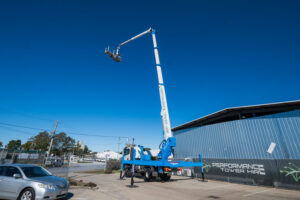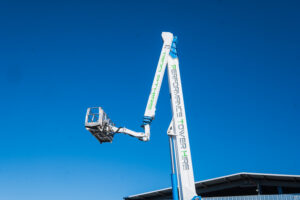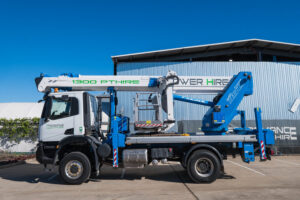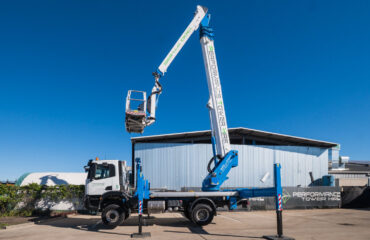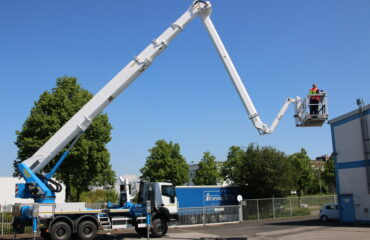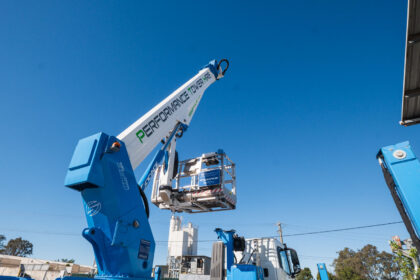
If you’ve ever looked up at a sign install or a roof repair and wondered what cherry pickers are and why tradies rely on them, this guide is for you. A cherry picker is a mobile elevating work platform (MEWP/EWP) with a hydraulic boom and a platform or bucket that safely lifts workers and tools to height. Once used in orchards, today they’re essential in construction, maintenance, utilities, arboriculture, signage, and events because they combine reach, safety, and efficiency.
Performance Tower Hire provides wet and dry hire across Brisbane and South East Queensland with a fleet ranging from 16 m to 54 m. If you need advice or pricing, get in touch with our expert team!
How a Cherry Picker Works
They use hydraulics to lift a platform or bucket, handy for spots you couldn’t get to safely otherwise. The layout might vary, but the basics don’t change much.
- Base/Chassis: Some can drive themselves around the site. Others sit on a truck so you can roll straight to the next job.
- Turntable/Turret: They spin a full 360 on most models, handy when you don’t want to keep shifting position.
- Boom: You’ve got two main kinds, articulated booms, which bend to get over stuff, and straight booms that just reach right out.
- Controls: There are controls up top and on the ground, with extras like emergency controls and safety switches built in.
- Fall protection points: There are anchor points built in so operators can clip on their harnesses.
Power Options
- Electric cherry pickers: They’re compact and don’t make a racket or stink the place up, so they’re good for indoors, think warehouses, shops, or fit-outs. They are also good for night works where noise is a consideration.
- Diesel cherry pickers: More power, more runtime, and built for tough conditions, perfect for jobs out in the open.
Height and Outreach
They all top out at different heights and reach. Ours go from 16 to 54 metres, so whether it’s a small job or a big multi-storey setup, you’re covered.
Types of Cherry Pickers
Different jobs call for different machines. Here are the most common types you’ll run into:
Articulated (Knuckle) Boom
These ones bend in a few spots, so the platform can get up and over things, handy for tight spots like over roofs, past awnings, or through trees. You’ll usually see the electric ones used inside, while diesel’s better for outdoors.
Telescopic Boom Lifts
These extend straight out, making them solid for things like installing big signage, working on bridges, or setting steel, any job where you need to go long without stuff in the way.
Truck-Mounted EWPs
Truck-mounted models are easy to move from site to site. They’re a go-to for power, comms, and sign teams who need to knock out a bunch of jobs without wasting time.
Compact & Indoor Models
These little units are slim enough to get through regular doorways and tight aisles. Great for inside spots where there’s not much room, and you don’t want loud engines or exhaust in the air.
Scissor Lifts vs Cherry Pickers
Scissor lifts just go up and down and give you a bit more room to move, good for ceilings or grabbing stock off high racks. Cherry pickers can reach out and around, so they’re better when you’ve got to reach over stuff.
Want the full breakdown? Check out the piece on how boom lifts and cherry pickers stack up.
Common Uses of Cherry Pickers
Practical cherry pickers cover a wide range of industries and tasks:
Construction and Maintenance
If you need to get up high for things like cleaning windows, painting, sealing, or roof work, a cherry picker’s the way to go. On reno jobs, they’re quicker than setting up a full scaffold.
Electrical and Telecoms
Utility crews use cherry pickers for all sorts of stuff, fixing power lines, swapping out streetlights, or working on comms gear up poles or buildings. The truck-mounted ones are easy to shift so that crews can hit a bunch of sites in a day.
Signage and Events
Cherry pickers get used for all sorts of installs, billboards, shopfront signs, and even stadium lights. Event crews use them for hanging lights and sound gear, and sometimes for camera rigs at concerts or shoots.
Arboriculture
They’re common with arborists and council crews for trimming, storm jobs, or cutting out dangerous limbs. Safer than dragging a saw up a tree. They even get used for wildlife rescues when nests are out of reach.
Emergency Access
In a pinch, storms, fires, rescues, and cherry pickers get crews up high quickly. They’re steady too, which is why emergency teams keep them on hand.
Benefits of Using Cherry Pickers
Key benefits of cherry pickers on site include:
Safer access than scaffolding
Cherry pickers give you a steady platform with tie-off points, so there’s less chance of slipping. It’s a much safer and more seamless process than building scaffolding and clambering up it to work on a job.
Faster setup and repositioning
Setting up a cherry picker once it’s on site takes no time at all. When you’re done with one spot, transportation to the next site is easy and efficient.
Higher productivity
Because they reach up and out, you can also reach a bunch of spots without moving the machine. That means less mucking around and more work done in the same day.
Flexibility across environments
Whether it’s small electrics for inside work or big truck-mounted rigs for rough ground, there’s a cherry picker to match. That’s why you see them everywhere, from construction sites to sign jobs, tree work, and telecoms.
Cost efficiency
When you hire a cherry picker, you get exactly the machine you need for that job. There’s no wasted money on equipment sitting idle. Plus, you skip the upkeep, storage, and big purchase cost.
For details on what influences hiring rates, see How Much Does Cherry Picker Hire Cost?
Safety Requirements in Australia
Cherry pickers are considered high-risk gear, so site leads and operators have to follow the rules, planning, training, and safe use.
Key Safety Steps
- Pre-start checks: Test all controls, emergency-lowering, brakes, tyres, guardrails, and interlocks. Record findings in the logbook and tag out any faults.
- Ground assessment: Confirm surface strength, slope, and underground services. Throw pads under the outriggers if the ground calls for it, and keep away from sketchy spots, edges, pits, that sort of thing.
- Exclusion zones: Put up signs or barriers so cars and people don’t wander into the work zone. Use traffic control on public roads.
- Overhead hazards: Before you start, scan the area for hazards like wires, trees, or nearby edges. If it’s risky, stay back or call the utility to cut it.
- Weather limits: Keep within the machine’s wind rating. Watch for gusts, rain, and lightning. Measure wind where the platform is working, not just at ground level.
- Harness use: Clip to approved anchor points in the basket of the cherry picker. Adjust the lanyard length to prevent ejection. Follow site rules for scissor lifts.
- Load management: Stay within the platform’s rated capacity (people + tools)—secure materials; never climb guardrails or use ladders in the basket.
- Spotter and communication: Use a trained spotter in public or congested areas. Agree on hand signals or radio calls before starting.
Licences and Training
- A High Risk Work (WP) licence is required for boom-type EWPs with a boom length of 11 m or more.
- For smaller machines, operators still need proof of competency. The EWPA Yellow Card is a widely accepted training for common EWP categories.
- Keep copies of licences and competency records on site.
Check out our comprehensive article on whether a license is required for cherry picker use.
Planning and Documentation
- Sort out a SWMS/JSEA that spells out the risks, how you’re managing them, what to do in a rescue, and who’s on each job.
- Make sure the operator’s manual stays in the machine. Make sure emergency numbers and the site address are easy to find.
- Confirm permits where needed (after-hours works, road occupancy, power isolation).
Emergency Readiness
- Have a rescue plan before elevating. At least one person on the ground must be able to operate the ground controls.
- Check that emergency-lowering devices are working and reachable.
- Keep first aid gear close to the work area.
Inspection, Maintenance, and Records
- Complete daily pre-starts and keep a logbook in the machine.
- Schedule periodic inspections by a competent technician and retain service records.
- Remove from service immediately if defects are found, and label the machine “out of use” until repaired.
Avoiding Mistakes
A lot of mistakes come down to simple stuff, ordering the wrong size, forgetting to check the ground, or setting up under wires.
For practical tips, see Mistakes to Avoid When Hiring a Cherry Picker.
How to Choose the Right Machine?
Picking a cherry picker? Keep these points in mind so you don’t run into headaches on the job.
- Height and outreach: Think about how high the work is and whether obstacles will get in your way.
- Site conditions: Check the ground before you set up, for a solid footing, not much slope, and enough room to get through the gates or doors.
- Power source: Electric ones are better indoors or anywhere you need them to be quiet. Diesel’s the go for outside jobs and rough ground.
- Capacity: Don’t forget to count the weight of whoever’s in the bucket, plus their gear and materials.
- Hire type: Wet hire, where you get an operator, makes sense for tricky jobs. Dry hire’s fine if you’ve already got licensed people who know the gear.
Need help choosing? The Cherry Picker Hire Brisbane team can match the right machine to your site and task.
Wrap-Up
What Are Cherry Pickers and Which One Do You Need?
By now, you’ve got the gist, cherry pickers are a safer way to get work done at height. Whether it’s a small electric for warehouses, a straight boom for long reach, or a truck unit for moving site to site, picking the right one keeps the job running smoother.
If you’re in Brisbane or South East Queensland, contact Performance Tower Hire for expert guidance and dependable equipment.
FAQs
Why are cherry pickers used in construction and maintenance?
They get you up high quicker and safer than messing around with ladders or scaffolding.
Why should businesses hire instead of buy?
Hiring avoids ownership costs and allows you to use the right machine for each job.
Why are electric cherry pickers popular indoors?
They are compact, quiet, and safe for enclosed environments.


